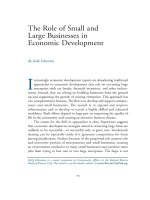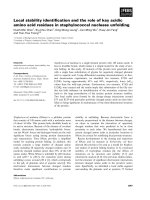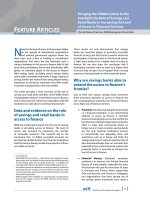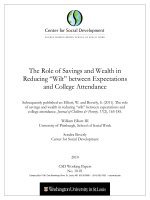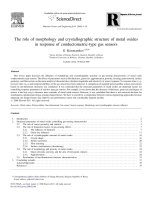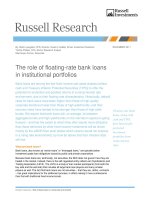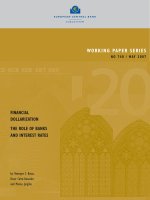gjerstad & smith - rethinking housing bubbles; the role of household and bank balance sheets in modeling economic cycles (2014)
Bạn đang xem bản rút gọn của tài liệu. Xem và tải ngay bản đầy đủ của tài liệu tại đây (6.4 MB, 310 trang )
Trim: 6in × 9in Top: 0.5in Gutter: 0.875in
CUUS2122-FM CUUS2122/Gjerstad ISBN: 978 0 521 19809 7 January 31, 2014 15:25
RETHINKING HOUSING BUBBLES
The Role of Household and Bank Balance Sheets
in Modeling Economic Cycles
Balance sheet crises, in which the prices of widely held and highly leveraged
assets collapse, pose distinctive economic challenges. An understanding of their
causes and consequences is only recently developing, and there is no agreement
on effective policy responses. From backgrounds in experimental economics,
Steven D. Gjerstad and Nobel Laureate Vernon L. Smith examine events that
led to and resulted from the recent U.S. housing bubble and collapse, as a
case study in the formation and propagation of balance sheet crises. They then
examine downturns in the U.S. economy over the past century, including the
Great Depression, and document substantive differences between the recurrent
features of economic cycles and financial crises and the beliefs that public
officials hold about them, especially within the Federal Reserve System. They
conclude with an examination of similar events in other countries and assess
alternative st rategies to contain financial crises and to recover from them.
Steven D. Gjerstad is a Presidential Fellow at Chapman University in Orange,
California. After receiving his Ph.D. in economics from the University of Min-
nesota, he worked for ten years on theoretical and computational models of
market-price-adjustment processes and on experimental tests of those models.
His work on price adjustment has appeared in Economic Theory, Games and
Economic Behavior, and the Journal of Economic Dynamics and Control.More
recently, his work examines adjustment processes in the aggregate economy,
with an emphasis on financial crises and economic restructuring. That work
has been published by the Wall Street Journal, the Critical Review, The American
Interest, the National Bureau of Economic Research, and the Cato Journal.
Dr. Vernon L. Smith was awarded the Nobel Prize in Economic Sciences in
2002 for his groundbreaking work in experimental economics. Dr. Smith has
joint appointments in the Arg yros School of Business and Economics and the
School of Law at Chapman University, and he is part of a team that created
and runs the Economic Science Institute there. Dr. Smith has authored or
co-authored more than three hundred articles and books on capital theory,
finance, natural resource economics, and experimental economics. Dr. Smith
has received an honorar y Doctor of Management degree from Purdue Univer-
sity, was elected a member of the National Ac ademy of Sciences in 1995, and
received CalTech’s Distinguished Alumni Award in 1996.
i
Trim: 6in × 9in Top: 0.5in Gutter: 0.875in
CUUS2122-FM CUUS2122/Gjerstad ISBN: 978 0 521 19809 7 January 31, 2014 15:25
ii
Trim: 6in × 9in Top: 0.5in Gutter: 0.875in
CUUS2122-FM CUUS2122/Gjerstad ISBN: 978 0 521 19809 7 January 31, 2014 15:25
Rethinking Housing Bubbles
The Role of Household and Bank Balance Sheets
in Modeling Economic Cycles
STEVEN D. GJERSTAD
Chapman University, California
VERNON L . SMITH
Chapman University, California
iii
Trim: 6in × 9in Top: 0.5in Gutter: 0.875in
CUUS2122-FM CUUS2122/Gjerstad ISBN: 978 0 521 19809 7 January 31, 2014 15:25
32 Avenue of the Americas, New York, NY 10013-2473, USA
Cambridge University Press is part of the University of Cambridge.
It furthers the University’s mission by disseminating knowledge in the pursuit of
education, learning, and research at the highest international levels of excellence.
www.cambridge.org
Information on this title: www.cambridge.org/9780521198097
C
Steven D. Gjerstad and Vernon L. Smith 2014
This publication is in copyright. Subject to statutory exception
and to the provisions of relevant collective licensing agreements,
no reproduction of any part may take place without the written
permission of Cambridge University Press.
First published 2014
Printed in the United States of America
A catalog record for this publication is available from the British Library.
Library of Congress Cataloging in Publication Data
ISBN 978-0-521-19809-7 Hardback
external or third-party Internet Web sites referred to in this publication and does not guarantee
that any content on such Web sites is, or will remain, accurate or appropriate.
iv
Trim: 6in × 9in Top: 0.5in Gutter: 0.875in
CUUS2122-FM CUUS2122/Gjerstad ISBN: 978 0 521 19809 7 January 31, 2014 15:25
Contents
Acknowledgments page xiii
1 Economic Crises, Economic Policy, and Economic Analysis 1
1.1 Macroeconomic Policy: Failed Expectations 1
1.2 Unanticipated Events Drive Economic Policy 3
1.2.1 Testing the Friedman-Schwartz Hypothesis 4
1.2.2 When the Test Failed, a “Forceful Policy Response”
Followed 5
1.3 Balance Sheet Recessions: A Missing Perspective 6
1.3.1 Leverage Cuts Deep on the Downside 8
1.3.2 The Role of Housing in Economic Fluctuation is Not
New 10
1.3.3 When Household Balance Sheets are Damaged, so
are Bank Balance Sheets 12
1.3.4 The Counterfactual Policy Paradox: Preventive
Action or Blame for Error? 15
1.3.5 When Monetary Policy is Ineffective, Fiscal Policy is
also Ineffective 15
1.3.6 Will New Models Save Us? 17
1.4 Experimental Markets and the Aggregate Economy 18
2 Goods and Services Markets versus Asset Markets 20
2.1 Two Types of Markets: The Good and the Sometimes Ugly 20
2.2 The Contrast between Markets for Nondurable Goods and
for Long-Lived Durable Assets 22
2.3 Markets for Consumer Nondurables 24
2.3.1 The Experiment Procedures: Motivating Trade 24
2.3.2 PricesEmergefromDecentralizedActionsGoverned
by Rules 25
v
Trim: 6in × 9in Top: 0.5in Gutter: 0.875in
CUUS2122-FM CUUS2122/Gjerstad ISBN: 978 0 521 19809 7 January 31, 2014 15:25
vi Contents
2.3.3 Supply and Demand for Perishables: Invisible Guide
to Best Social Outcomes 27
2.3.4 Two Early Experiments: Falsifying an “Explanation” 30
2.4 Asset Markets 33
2.4.1 Asset Markets: Unanticipated Bubbles on the Way to
Equilibrium 34
2.4.2 Learning from the Bubble Generator 35
2.5 Modeling Bubbles: The Interaction between Fundamental
and Momentum Components of Trading Behavior 41
2.5.1 More Money, Bigger Bubbles 42
2.5.2 It’s Money all the Way to the End 44
2.6 Summary: Markets, Panics, and Manias: When Are
Crowds Wise and When Are They Not? 45
3 Asset Performance: Housing and the Great Recession 49
3.1 Expansion of the Real Estate Bubble and Onset of the
Recession 50
3.1.1 Momentum Characteristics of the Developing
Bubble 51
3.1.2 The Course of the Recession 53
3.1.3 Lingering Repercussions of the Bubble and Recession 55
3.2 Parallels in Behavior: Laboratory and Housing Market
Asset Bubbles 56
3.2.1 Liquidity Influences the Magnitude of the Bubble
and Its Subsequent Collapse 56
3.2.2 Trade Quantities Fall While Prices Continue to Rise
or Flatten Out 57
3.2.3 Prices Turn and Collapse While Trade Quantity
Continues to Decline 59
3.3 Mortgage Finance Supported the Bubble until It Was
Withdrawn 60
3.3.1 Self-Sustaining Expectations in the Housing,
Mortgage, and Derivatives M arkets 60
3.3.2 Money Mattered: The Flow of Mortgage Funds Grew
Dramatically During the Bubble 62
3.3.3 Money from Abroad: Foreign Investment Inflated
the Bubble 65
3.3.4 Housing Affordability Fell as Credit Pushed Up
Prices 67
3.3.5 Low-Priced Homes had a Bigger Bubble 69
Trim: 6in × 9in Top: 0.5in Gutter: 0.875in
CUUS2122-FM CUUS2122/Gjerstad ISBN: 978 0 521 19809 7 January 31, 2014 15:25
Contents vii
3.3.6 Mortgage Leverage was Extreme During the Bubble 70
3.3.7 Mortgage Delinquency Reversed the Flow of
Mortg age Funds 71
3.3.8 Leverage Cuts Brutally on the Downside 71
3.4 Housing Equity, Negative Equity, and the Transmission of
Borrowers’ Losses 73
3.4.1 Households’ Equity in the Housing Stock 73
3.4.2 Negative Equity Became Widespread After Prices Fell 75
3.4.3 Borrowers’ Losses were Transmitted to the Financial
Sector 76
3.5 Housing and Key Components of GDP in the Great
Recession: The Two Types of Markets Again 77
3.6 Summary: The Great Recession Has Unusual Persistence 80
4 The Great Depression 85
4.1 Interpretations of the Great Depression 85
4.1.1 Friedman and Schwartz versus Real Business Cycle
Interpretations 86
4.1.2 Economic and Banking Conditions in 1930 87
4.1.3 Mortgage Leverage and a Housing Collapse Amplify
Distress in a Downturn 89
4.1.4 Household Balance Sheet Stress and the
Consumption Decline in 1930 90
4.2 Changes in Output by Sector 91
4.3 Residential Mortgage Debt Boom and Increasing Leverage 94
4.4 Housing-Sales and House-Price Declines, 1926–1933 98
4.4.1 Housing Sales Decline 98
4.4.2 House Price Movements, 1926–1933 100
4.5 Mortgage Bond Defaults, Mortgage Delinquency and
Foreclosure, and Unemployment 103
4.5.1 Mortgage Bond Defaults 104
4.5.2 Mortgage Delinquency and Foreclosures 106
4.6 Urban Bank Stress from Real Estate 110
4.7 Summary: Channels of Contraction 113
4.7.1 Reduced Residential Construction 113
4.7.2 Damage to Household Balance Sheets 114
4.7.3 Reduction of Firms’ Inventories, Production, and
Fixed Investments 115
4.7.4 Feedback Effect on Households’ Incomes 116
4.7.5 Damage to Banks’ Balance Sheets 116
Trim: 6in × 9in Top: 0.5in Gutter: 0.875in
CUUS2122-FM CUUS2122/Gjerstad ISBN: 978 0 521 19809 7 January 31, 2014 15:25
viii Contents
4.8 Conclusions 118
5 The Postwar Recessions 122
5.1 The Major Downturns 123
5.1.1 The 1973–1975 Recession 123
5.1.2 The 1980 and 1981–1982 Recessions: The
Fed-Housing Economic Cycle Revealed 125
5.2 The Minor Recessions 128
5.2.1 The 1948–1949 Recession 128
5.2.2 The 1953–1954 Recession 130
5.2.3 The 1957–1958 Recession 132
5.2.4 The 1960–1961 Recession 133
5.2.5 The 1969–1970 Recession 134
5.2.6 The 1990–1991 Recession 136
5.2.7 The 2001 Recession: Finally, a Business
Investment Recession 137
5.3 Summary of GDP Component Changes 140
5.4 Conclusions 143
6 What May Have Triggered or Sustained the Housing Bubble
(1997–2006)? 146
6.1 What May Have Triggered the Housing Bubble
(1997–2001)? 148
6.1.1 The Taxpayer Relief Act of 1997 148
6.1.2 Evaluating the Role of Public Housing Policy:
Government Sponsored Enterprises and the
Community Reinvestment Act 149
6.2 What May Have Sustained and Continued the Housing
Bubble (2002–2006)? 166
6.2.1 Unprecedented Monetary Ease (2001–2003) versus
Foreign Investment 166
6.2.2 Derivatives 168
6.3 Sweeping up the Broken Glass 169
6.4 Conclusions 170
7 The Bubble Bursts: Subprime Mortgages, Derivatives, and
Banking Collapse 173
7.1 Financial “Innovations” in the Mortgage Market:
Mortgage Backed Securities and Credit Default Swaps 174
7.2 Can You Insure Against Business Risk of Loss? 177
Trim: 6in × 9in Top: 0.5in Gutter: 0.875in
CUUS2122-FM CUUS2122/Gjerstad ISBN: 978 0 521 19809 7 January 31, 2014 15:25
Contents ix
7.3 Flaws at the Center of CDS Instruments 180
7.4 The Gathering Storm and the Collapse of the CDS, MBS,
and Loan Origination Markets 182
7.5 Cry in the Wilderness: The Commodity Futures Trading
Commission Raises Key Questions, Summarily Rejected,
Subsequently Vindicated 190
7.6 Other War nings as Catastrophe Neared 193
7.7 Complexity Surges: The Dodd-Frank Fix 194
7.8 Origins in Financial Market Legislation of the 1980s 196
7.9 Conclusions 199
8 Blindsided Experts 203
8.1 From Monitoring Events and Fighting Inflation to
Surprise and Adaptation 204
8.1.1 Federal Reserve Adaptation I: Concerns Switch from
Inflation to the Provision of Liquidity 207
8.1.2 Federal Reserve Adaptation II: An Implicit
Acknowledgment That It Was a Solvency Crisis 210
8.2 Continuous Adaptation: Still More Fed Easing Was to
Follow 216
8.3 Why Do Housing Market Crashes Bring Recession but
Stock Market Crashes Do Not? 217
8.4 Pause for Reflection 221
9 What Mig ht Be Done? 223
9.1 Incentives and Human Betterment 224
9.2 The Blame Game 226
9.3 “Regulation” as Incentive-Compatible Property Rights 227
9.3.1 Mortgages 230
9.3.2 Derivatives 232
9.3.3 Rating agencies 233
9.3.4 Transparency 233
9.3.5 Proprietary Trading and Depository Institutions
(the Volcker Rule) 233
9.3.6 The Fed Rewrites Its Rules 234
9.4 Bailouts: Banks but Not Homeowners? 235
9.5 Monetary Policy 240
9.6 Taxation Policy 242
9.6.1 Household Income Taxes 242
9.6.2 Business Income Taxes 245
Trim: 6in × 9in Top: 0.5in Gutter: 0.875in
CUUS2122-FM CUUS2122/Gjerstad ISBN: 978 0 521 19809 7 January 31, 2014 15:25
x Contents
9.7 Business Policy: Entry Cost by New Firms Should
Be Low 245
10 Learning from Foreign Economic Crises: Consequences,
Responses, and Policies 251
10.1 Introduction and Overview 251
10.2 Bankruptcy and Default as a Healthy Balance Sheet
Repair and Reboot Process 254
10.3 Protecting Incumbent Investors from Losses: Recipe for
Postponing Recover y? 256
10.4 Learning from Market Currency Depreciation in Three
of Many Countries: Finland (1990–1993), Thailand
(1994–2003), and Iceland (2007–2010) 258
10.4.1 Finland 260
10.4.2 Thailand 261
10.4.3 Iceland 263
10.5 Fiscal Consolidation versus Fiscal Stimulus and Deficit
Spending 264
10.6 Conclusion 266
11 Summarizing: What Have We Learned? 268
11.1 Balance Sheet Crises and Housing: Definition and
Occurrence 268
11.2 Housing Leads in Most Recessions 268
11.3 Two Types of Markets in Experiments and the Economy 269
11.4 Build-Up and Collapse: Overview of the Great Recession 271
11.5 Revisiting the 1920s and the Depression 272
11.6 Household Equity : Depression versus Great Recession 273
11.7 The Post–World War II Recessions 275
11.8 The Housing Bubble: Were There Triggers? 276
11.9 The Great Recession: Incentives, Mortgage Backed
Securities, and Derivatives 277
11.10 The Great Recession: Economic Policy Lags the
Housing-Mortgage-Market Decline 278
11.11 International Crises-Management “Experiments”
Supplement the Limited U.S. Experience: Sweden versus
Japan; Finnish, Thai, and Icelandic Fiscal Discipline 280
11.12 Thinking about What Might Be Done 281
Trim: 6in × 9in Top: 0.5in Gutter: 0.875in
CUUS2122-FM CUUS2122/Gjerstad ISBN: 978 0 521 19809 7 January 31, 2014 15:25
Contents xi
11.12.1 Thinking in Terms of Incentive-Compatible
Property Rights, Not Politically Charged
“Regulation” 281
11.12.2 Monetary Policy Needs to Account for Its Own
Effect and that of Foreign Investment 283
11.12.3 Consumption and Growth-Focused Tax and
Business Policies 284
11.13 Conclusions 286
Index 287
Trim: 6in × 9in Top: 0.5in Gutter: 0.875in
CUUS2122-FM CUUS2122/Gjerstad ISBN: 978 0 521 19809 7 January 31, 2014 15:25
xii
Trim: 6in × 9in Top: 0.5in Gutter: 0.875in
CUUS2122-FM CUUS2122/Gjerstad ISBN: 978 0 521 19809 7 January 31, 2014 15:25
Acknowledgments
Chapter 4 was first published by the University of Chicago Press in 2014 as
“Consumption and Investment Booms in the Twenties and Their Collapse
in 1930” in Housing and Mortgage Markets in Historical Perspective,edited
by Eugene N. White, Kenneth Snowden, and Price Fishback.
Selections from Chapters 5 and 10 first appeared in the May/June 2012
issue of The American Interest as “Underwater Recession” which was coau-
thored with Joy A. Buchanan. More extensive selections from the same two
chapters were published as Chapter 5 in The 4% Solution, edited by Brendan
Miniter .
Portions of Chapters 6 and 7 first appeared in 2009 in our paper “Mone-
tary Policy, Credit Extension, and Housing Bubbles: 2008 and 1929” in the
Critical Review.
Chapter 10 is a substantial revision of our keynote presentation at
the Cato 30th Annual Monetary Conference, published as “Balance Sheet
Crises: Causes, Consequences, and Responses” in the Fall 2013 issue of the
Cato Journal.
xiii
Trim: 6in × 9in Top: 0.5in Gutter: 0.875in
CUUS2122-FM CUUS2122/Gjerstad ISBN: 978 0 521 19809 7 January 31, 2014 15:25
xiv
Trim: 6in × 9in Top: 0.5in Gutter: 0.875in
CUUS2122-01 CUUS2122/Gjerstad ISBN: 978 0 521 19809 7 January 30, 2014 11:36
1
Economic Crises, Economic Policy,
and Economic Analysis
The committee determined that a trough in business activity occurred in the U.S.
economy in June 2009. The trough marks the end of the recession that began in
December 2007 and the beginning of an expansion. The recession lasted 18 months,
which makes it the longest of any recession since World War II.
– Business Cycle Dating Committee, National Bureau of Economic Research,
September 20, 2010
The crisis showed that the standard macroeconomic models used by central bankers
and other policymakers . . . contain . . . no banks. They were omitted because
macroeconomists thought of them as a simple “veil” between savers and borrowers.
– The Economist, January 19, 2013
1.1 Macroeconomic Policy: Failed Expectations
In a speech on January 10, 2008, when the National Bureau of Economic
Research (NBER) had yet to declare that a recession had begun in the
previous month, Chairman of the Federal Reserve Ben Bernanke stated:
“We stand ready to take substantive additional action as needed to support
growth and to provide adequate insurance against downside risks.” Then,
in response to a question following his speech, Bernanke replied that “The
Federal Reserve is not currently forecasting a recession” but noted that it
was, however, “forecasting slow growth.”
1
1
Bernanke’s speech is available from the Board of Governors of the Federal Reserve at www.
federalreserve.gov/newsevents/speech/2008speech.htm. For an account of the questions
and answers following the speech, see Associated Press (2008). Four weeks earlier, as the
recession got underway in December 2007, the Federal Open Market Committee (FOMC)
in its policy deliberations did not foresee anything more than a slowdown of growth or a
moderate recession. The transcript of the FOMC meeting on December 11, 2007, includes
statements by many of the FOMC members, and the consensus forecast was near-zero
growth for 2008. Janet Yellin, President of the Federal Reserve Bank of San Francisco,
1
Trim: 6in × 9in Top: 0.5in Gutter: 0.875in
CUUS2122-01 CUUS2122/Gjerstad ISBN: 978 0 521 19809 7 January 30, 2014 11:36
2 Rethinking Housing Bubbles
Then, on June 9, 2008 – six months into the Great Recession and with
twelve months still to go – Bernanke reiterated in a prepared speech that
“Although activity during the currentquarteris likelytob e weak, therisk that
the economy has entered a substantial downturn appears to have diminished
over the past month or so” (Bernanke, 2008).
At this juncture (June 9, 2008):
r
New housing construct ion expenditures had declined w ithout inter-
ruption for nine quarters; by the time Bernanke made his January 10
speech, it had registered a 44 percent decline, and by June 9, new hous-
ing construction was down 51 percent. At the time of the December
2007 Federal Open Market Committee (FOMC) meeting, new hous-
ing construction expenditures had fallen without interruption for six
quarters and the total decline, at 36.1 percent, had reached a level
exceeded only in the serious 1973–75 recession and the even larger
combined decline in the double-dip recessions of 1980 and 1981–82.
r
The net flow of mortgage funds had recently turned negative for the
first time in any peacetime period since the Depression interval from
1932 to 1937.
2
r
During the entire post–World War II p eriod, there had never been
a decline in excess of 10 percent in expenditures on new housing
construction that had not been followed soon afterward by a recession.
What became transparent in the economic policy narrative leading up
to 2007 and its aftermath was the stunning inability of officials and
economists – in the wake of declining residential construction expendi-
tures – to anticipate the approaching economic catastrophe, to fully recog-
nize its arrival when it had engulfed them, or to believe in and accept its
severity.
3
stated that her “modal forecast foresees the economy barely managing to avoid recession,
with growth essentially zero this quarter and about 1 percent next quarter.” Vice Chairman
Geithner stated that “our modal forecast [has] several quarters of growth below potential
with real GDP for ’08 a bit above 2 p ercent.” See Board of Governors (2007).
2
There have been only three per iods during the past 115 years when the net flow of mortgage
funds has beennegative: star ting in the Great Depression in1932 andcontinuing for several
years into the recovery until 1937; from 1942 to 1944, when there were wartime restrictions
on availability of construction materials; and from Q2 2008 through Q2 2013. Mortgage
credit comprises about three quarters of all credit to households. Hence, the collapse of
the housing and mortgage markets in 2007 and 2008 initiated the most serious episode of
household deleveraging since the Depression.
3
The two most serious declines in residential construction between the end of World War
II and the Great Recession were associated with the two most severe economic downturns
during that period (i.e., the 1973–5 recession and the 1980, 1981–2 double-dip recession).
Trim: 6in × 9in Top: 0.5in Gutter: 0.875in
CUUS2122-01 CUUS2122/Gjerstad ISBN: 978 0 521 19809 7 January 30, 2014 11:36
Economic Crises, Economic Policy, and Economic Analysis 3
Clearly, the role of households in economic cycles – operating through
their acquisition of credit-financed new homes – had not been appreciated
by the economics profession, the investment community, and policy makers.
Our primary objectives in the chapters that follow are to examine the role of
housing in past recessions, with a special focus on its role in severe cases that
take the form of balance sheet recessions – that is, recessions that accompany
severe deterioration in the balance sheets of households and financial firms –
and to demonstrate that the role of housing in severe economic cycles has
been largely neglected.
1.2 Unanticipated Events Drive Economic Policy
Five months before Bernanke’s January 10, 2008, speech forecasting low
growth (but not a recession), the FOMC suddenly reversed its policy. On
August 7, 2007, the FOMC press release reiterated its ongoing primary con-
cern about inflation; then, its August 10, 2007, press release switched to
concern about “dislocations in money and credit markets.” The latter was
precipitated by a rapid surge in July 2007 in the cost of insuring AAA rated
mortgage securities with credit default swaps.
4
The problems with insuring
those risks raised the cost of issuing new securities and also informed mar-
ket participants that insurers were concerned about the quality of existing
securities. On August 9, 2007, BNP Paribas suspended withdrawals from
three of its investment funds that were heavily invested in U.S. subprime
mortgage securities after the prices of those securities fell more than 20
percentinlessthantwoweeks.
This sharp policy reversal revealed the extent to which Bernanke and
the Federal Reserve were engulfed by unanticipated events, but it also indi-
cates their willingness to act once the unexpected collapse had necessitated a
change in policy stance. Bernanke, specifically, and monetary policy experts,
generally, were familiar with the argument in Bagehot (1873)thatduring
a financial crisis, “advances should be made on all good banking securi-
ties.” They were also familiar with the argument made ninety years later
Surely, the collapse of residential construction should have been a cause for greater concern
in 2007 and 2008. Even the collapse of residential construction understates the severit y of
the situation because the previous downturns did not include a sharp decline of housing
prices and the resulting sharp reduction in households’ equity in their homes.
4
The Markit ABX indices of credit default swaps on AAA rated mortgage-backed securities
were trading near par on July 6, 2007, reflecting the market belief that these securities
would incur no losses at al l. By the end of July, these securities were trading at under $0.90,
which reflects a market belief that losses on these securities could reach 10 percent.
Trim: 6in × 9in Top: 0.5in Gutter: 0.875in
CUUS2122-01 CUUS2122/Gjerstad ISBN: 978 0 521 19809 7 January 30, 2014 11:36
4 Rethinking Housing Bubbles
by Friedman and Schwartz (1963) that the Federal Reserve had allowed a
normal cyclical downturn to develop into the Great Depression through
its failure to follow Bagehot’s dictum to provide sufficient liquidity to the
banking system.
5
Indeed, there would turn out to be powerful parallels
between the events of late 1930 and late 2007, except for one command-
ing difference: The Federal Reserve adopted a “forceful policy response” to
insure that conditions in the financial market did not deteriorate between
2007 and 2009 as they had between 1930 and 1932. But that policy response
was constructed “on the fly” and did not incorporate much of the learning
from other comparable crises, such as the relatively successful resolution of
the Swedish and Finnish crises in 1992 or the far less successful response
to the Japanese “lost decade.” One of our key objectives in this book is to
demonstrate that in balance sheet crises such as the Great Depression and
the Great Recession, liquidity alone cannot solve the problem, and that the
economics profession and monetary policy experts have not distinguished
adequately between tight money markets that require an infusion of liq-
uidity and balance sheet crises that involve widespread insolvency among
households and financial institutions; neither have they determined the best
policy responses to w idespread insolvency.
1.2.1 Testing the Friedman-Schwartz Hypothesis
After serious problems developed early in August 2007 in the subprime
mortgage sector and those problems began to affect financial institutions
that were heavily invested in subprime mortgages, the Federal Reserve
shifted decisively toward a policy of “liquidity enhancement.”
6
However,
that policy of traditional short-term injections of liquidity – vigorously pur-
sued and greatly expanded in size and duration between August 2007 and
5
We examine this argument in detail in Chapter 4 and reach a somewhat different con-
clusion. We argue in that chapter that economic conditions in 1930 were similar to those
in 2007. Hence, the Federal Reserve was probably not in a position to completely avoid a
major downturn. Yet, the unusual deterioration of conditions in the financial sector was
likely a significant contributor to the severity of the Great Depression, exacerbating an
already adverse and challenging economic environment.
6
Although the total assets of the Federal Reserve grew slowly between August 2007 and
August 2008, the composition of those assets shifted substantially away from U.S. Treasury
securities and toward Repurchase Agreements and Term Auction Credit after August
2007. Changes to Federal Reserve holdings of these two types of assets can be tracked on a
weekly basis in Federal Reserve Statistical Release H.4.1. We describe the Fed response to
the financial market distress between August 2007 and September 2008 in “Federal Reserve
Adaptation I” in Chapter 8,Section8.1.2.
Trim: 6in × 9in Top: 0.5in Gutter: 0.875in
CUUS2122-01 CUUS2122/Gjerstad ISBN: 978 0 521 19809 7 January 30, 2014 11:36
Economic Crises, Economic Policy, and Economic Analysis 5
October 2008 – would be woefully inadequate. Federal Reserve policy would
again and much more radically be shifted as a consequence of further finan-
cial market deterioration. Between September 10 and October 22, 2008, the
assets and the liabilities of the Federal Reserve Bank system increased by well
over 100 percent.
7
Bernanke had tested the Friedman-Schwartz hypothesis
with dedication for more than a year after August 10, 2007. In September
2008, as the balance sheets of financial institutions came under increasing
stress and scrutiny from funding sources, the liquidity enhancement mea-
sures pursued in the previous thirteen months proved entirely impotent,
and the Federal Reserve perforce intervened on an unprecedented scale to
maintain a functioning financial system. For the previous thir teen months,
the Federal Reserve had been fighting a liquidity problem, not the insolvency
problem that was infecting financial institutions. Moreover, these entities
were no longer only depository institutions but also included investment
banks heavily invested in mortgages, mortgage securities, and derivatives
based on mortgage securities. These securities and derivatives both plum-
meted in value in July 2007. When the pricesof these assets collapsed, thebal-
ance sheets of many financial firms were adversely impacted. In Chapter 3,
we describe the expansion and collapse of the housing and mortgage mar-
kets. In Chapter 7, we examine the market for credit default swaps on
mortgage securities. In Chapter 8, we examine the views of the Federal
Reserve on those markets.
1.2.2 When the Test Failed, a “Forceful Policy Response” Followed
Four years after the crisis, in his March 27, 2012, retrospective lecture at
George Washington University (GWU), Bernanke (2012b) said: “I think
the v iew is increasingly gaining acceptance that without the forceful policy
response that stabilized the financial system in 2008 and early 2009, we
could’ve had a much worse o utcome in the e conomy .”
However, the “forceful policy response” he described at GWU reached
far beyond his thinking in the earlier speeches of January 10 and June 9,
2008. It was an entirely new response driven by events that had overtaken
previous policy but also, and significantly, the entire current pattern of
thinking at the Federal Reserve and among economists. Moreover, in the
new response, the U.S. Treasury had entered prominently into the policy
arena, first w ith the $152 billion Economic Stimulus Act of 2008 early in
7
We describe the Federal Reserve response to the crisis in more detail in “Federal Reserve
Adaptation II” in Chapter 8 Section 8.1.2.
Trim: 6in × 9in Top: 0.5in Gutter: 0.875in
CUUS2122-01 CUUS2122/Gjerstad ISBN: 978 0 521 19809 7 January 30, 2014 11:36
6 Rethinking Housing Bubbles
the year, followed by the $700 billion Emergency Economic Stabilization
Act of 2008, and concluded with the $830 billon American Recovery and
Reinvestment Act of 2009. These fiscal actions, totaling almost $1.7 trillion,
came on the heels of the 2007–8 liquidity actions, followed by the 2008–
9 solvency-promoting actions of the Federal Reserve.
8
A program that is
costing somuch and producing suchhigh deficits requiresclose examination
to determine whether it has benefited or h armed the economy. Beliefs
and analyses on that issue differ widely. Following our assessment of t he
characteristics and causes of balance sheet crises, we turn in Ch apter 10 to
the question of the impact of alternative p olicies, including alternative fiscal
policies in other countries that have experienced comparable downturns.
Neither the monetary nor the fiscal responses tothe crisis satisfied anyone.
The depth of the downtur n, the slow recovery of output, and the persistent
loss of jobs and income have been deeply disappointing. Policy makers faced
economic challenges that did not respond to the old tools of low short-term
interest rates or to fiscal expansion. The Depression could not provide a
guideline because this time, the Federal Reserve had ostensibly acted as the
circumstancesdictated by providing all of the support for which the financial
sector could hope, and the government had increased spending and reduced
revenue, as Keynesians prescribe. Why have these classic prescriptions failed
to produce the desired results? What is wrong with the premises underlying
economic analysis and policy?
1.3 Balance Sheet Recessions: A Missing Perspective
In our view, the prominent role of balance sheets is the missing link in
answering these questions and accounting for the abrupt turns and reversals
as economic thinking and policy lagged behind the twisting curve of events.
Both Keynesian and microeconomic equilibrium analyses model flows of
goods, services, labor, and capital investment. When household and bank
balance sheets are predominantly in positive equity, these flows behave with
far more regularity than when they are weighed down by numerous balance
8
Between 2002 and 2007, federal budget deficits averaged $304.8 billion. After the crisis,
between 2009 and 2012, federal budget deficits were more than $1 trillion in each of
the four years and averaged $1,273.4 billion per year. T he figure for the earlier period
was an average of 2.4 percent of GDP; for the later period, it averaged 8.4 percent of
GDP. For budgets, see the Office of Management and Budget Historical Tables, available
at www.whitehouse.gov/omb/budget/historicals. For GDP, see the National Income and
Product Accounts from the Bureau of Economic Analysis in the Department of Commerce,
available at www.bea.gov/iTable/index
nipa.cfm.
Trim: 6in × 9in Top: 0.5in Gutter: 0.875in
CUUS2122-01 CUUS2122/Gjerstad ISBN: 978 0 521 19809 7 January 30, 2014 11:36
Economic Crises, Economic Policy, and Economic Analysis 7
sheets in negative equity. It is this condition that looms large in economic
calamities such as the Great Recession and the Depression. The Great Reces-
sion was preceded by a long period of expansion in the construction of new
homes, driven by an expansion in the net flow of mortgage credit in excess
of the growth in income that might otherwise have sustained an increased
demand for new homes. Accompanying this mortgage credit expansion
was a rise in inflation-adjusted home prices from 1997 into 2006. (See
Figures 3.2 and 3.3 in Chapter 3 for charts of home sales, home prices, and
the flow of mortgage credit.) When the collapse came, home values declined
against fixed mortgage debt, and households and their creditor banks were
plunged into rapidly escalating negative equity – a pit that massively dis-
rupted the ordinary flows of economic activity across decision-making
entities.
9
This large decline in household wealth contributed significantly
to a disruption of the normal flows of goods and services as well as the
payments for them, including the flows of payments for labor services.
Reduction by households of their expenditures relative to income – espe-
cially for new housing units and consumer durable goods, the purchase of
which can be readily postponed – contributed significantly to the disruption
of normal flows.
10
These developments are characteristic of balance sheet recessions. Busi-
nesses reduce their current outlays in step with declining consumer expen-
ditures and they postpone new capital expenditures. Banks reduce lending
and allow the incoming debt-service payments to improve liquidity. Precau-
tion is everywhere present as households and the financial sector deleverage
and non-financial businesses await renewed growth before they invest in
inventories and new production capabilities.
In Chapter 5, we show that when the Federal Reserve reduces short-term
interest rates by purchasing U.S. Treasury debt, that policy shift has its most
significant effect on mortgage lending. However, in a downturn such as the
recent Great Recession, no amount of bond purchases by the Federal Reserve
could encourage banks to issue new mortgages. Simultaneously, households
were saturated in debt and house prices were falling; hence, the demand for
new home mortgages was extremely low. With aggregate output low, the
demand for new investments by firms also was suppressed, so the impact of
9
In Chapter 3, we examine the impact of the collapse of home prices in detail and how that
collapse affected home equity. As Figure 3.7 shows, home equity fell more than 50 percent
from early 2006 to early 2009.
10
In Chapter 3, we also examine these usual flows and their disruption during the Great
Recession. Figure 3.8 depicts this pattern of expenditures on new residential structures,
household durable goods, and non-residential fixed investment.
Trim: 6in × 9in Top: 0.5in Gutter: 0.875in
CUUS2122-01 CUUS2122/Gjerstad ISBN: 978 0 521 19809 7 January 30, 2014 11:36
8 Rethinking Housing Bubbles
monetary policy was severely blunted. Keynesians conclude that when mon-
etary policy is ineffective, fiscal policy will stimulate the economy. However,
we argue that the revenue side of fiscal policy is also blunted for a similar
reason: Tax reductions to households do not stimulate household spending
to the usual extent because households are in a defensive posture and they
use the extra income to pay down debt or for precautionary savings. Other
evidence suggests that fiscal stimulus cannot restore growth. Countries that
responded to downturns like the one that the United States experienced
in 2008 and 2009 with sustained deficit spending have been mired in slow
growth for years, whereas countries that responded by curtailing deficit
spending have returned quickly to a sustained period of rapid growth.
Because these large-scale domestic episodes are exceptional –twice now in
eighty yearsin theUnited States –it is perhaps understandablethat economic
and policy thinking has not accounted for them. Consequently, our search
for understanding includes anexamination (see Chapter 10) of the responses
that at different times have characterized many countries that share in
common a collapsed investment boom that was fueled by credit. These
countries vary in size, from Iceland to Japan, and constitute a rich set of
“experiments” in economic surges and reversals, as well as the diverse policy
responses that have been undertaken in response to them. Notable examples
of such crises include Japan after the bubble collapsed in 1990–91, Finland
and Sweden after their downturns in 1990–93, the East Asian crisis countries
in 1997–98, the United States in the financial crisis, and the peripheral
countries of the European Union in recent years. Comparison of cr ises
and responses in these countries can help distinguish policies that promote
recovery and growth from those that retard recovery and reduce growth.
1.3.1 Leverage Cuts Deep on the Downside
The impact of balance sheet stress on family net worth – as distinct from
income flows in severe crises – is reflected in a report by Bricker et al.
(2012), which the authors based on a comparison of the 2004, 2007, and
2010 editions of the Survey of Consumer Finances from the Federal Reserve.
Tabl e 1.1 summarizes the percentage changes in median and mean family
income and net worth (i.e., the difference between families’ gross assets
and their liabilities) for one period late in t he housing bubble (from 2004
to 2007) and for the period from its peak until near its low point (from
2007 to 2010). For brevity, we focus on the changes among the three most
recent surveys because the 2007 survey fell near the peak of the economic
Trim: 6in × 9in Top: 0.5in Gutter: 0.875in
CUUS2122-01 CUUS2122/Gjerstad ISBN: 978 0 521 19809 7 January 30, 2014 11:36
Economic Crises, Economic Policy, and Economic Analysis 9
Table 1.1. Changes in family income and net worth in survey periods comparing
2004 with 2007, and 2007 with 2010
Percent changes in median and mean income and net worth measured relative to
previous survey results
Survey years 2004 to 2007 2007 to 2010
Measure Median Mean Median Mean
Income Change Nil +8.5 − 7.7 −11.1
Net Worth Change +17.9 +13.1 − 38.8 −14.7
Source: Bricker et al. (2012). All changes are measured in i nflation-adjusted dollars, and income is
measured before taxes.
cycle. Therefore, these surveys provide snapshots of household income and
wealth changes before and after the housing market collapse.
We observe that from 2004 to 2007, mean income rose 8.5 percent with
no change in the median, indicating that the income of families above the
middle improved relative to thosebelow.Both groups suffered adecline from
2007 to 2010, with those above the middle falling more than those below
(mean change –11.1 percent, median change –7.7 percent). As elaborated
in the report by Bricker et al. (p. 4): “The changes for both periods stand in
stark contrast to a pattern of substantial increases in both the median and
the mean dating to the early 1990s.”
From 2004 to 2007,however, median net worth grew notably more (+17.9
percent) than the mean (+13.1 percent), indicating that programs designed
to enable those of lesser means to benefit from homeownership appeared
to be working as intended. However, this relative improvement proved to
be ephemeral. From 2007 to 2010, median net wealth fell (–38.8 percent)
far more than the mean (–14.7 percent).
The Bricker et al. report noted (p. 17) that “Mean net wor th fell to about
the level in the 2001 survey, and median net worth was close to levels not
seen since the 1992 survey.” For the most recent 2007 to 2010 comparisons,
the report further elaborated (pp. 1–2) on the striking changes in the median
and mean measures of income and net worth shown in Tabl e 1. 1:
The decline in median income was widespread across demographic groups, with
only a few groups experi encing stable or rising incomes. Most noticeably, median
incomes moved higher for retirees and other nonworking families. T he decline
in median income was most pronounced among more highly educated families,


